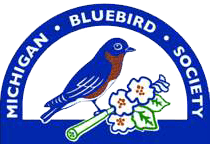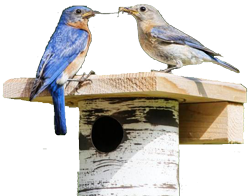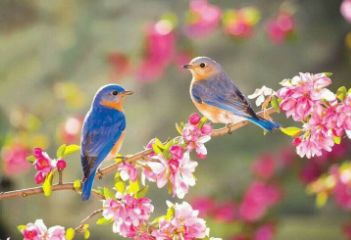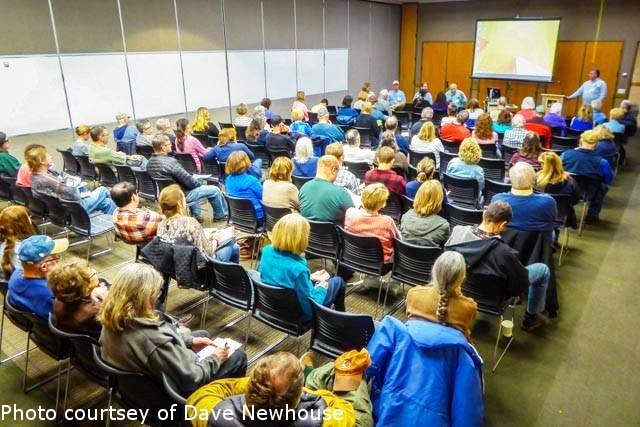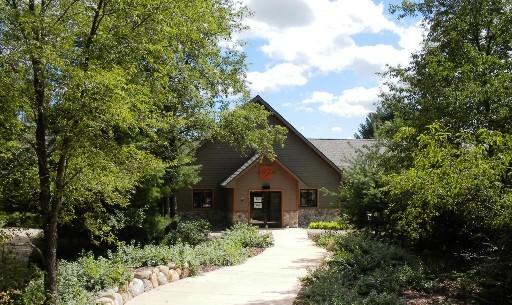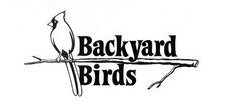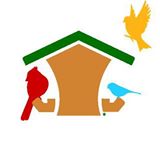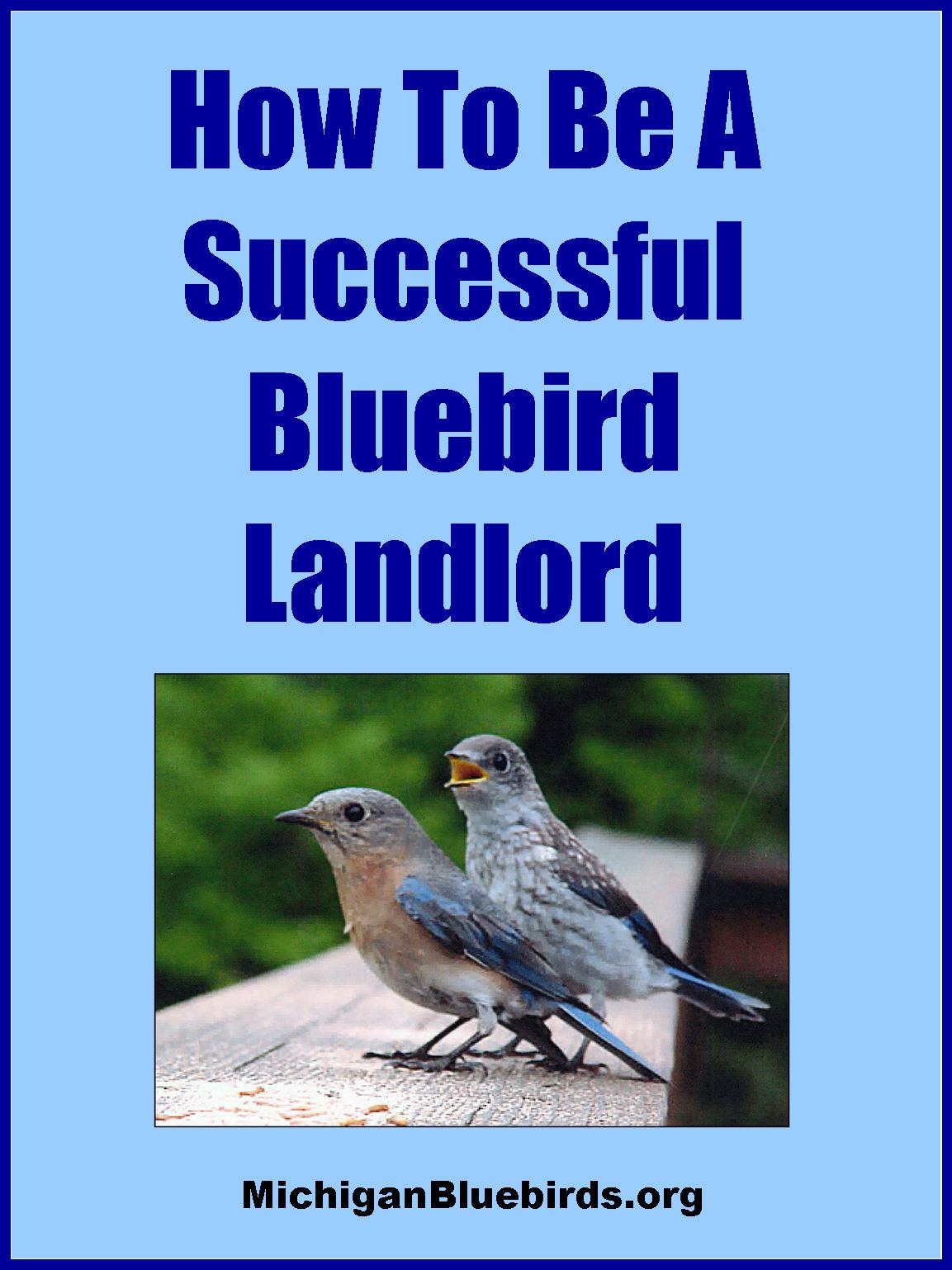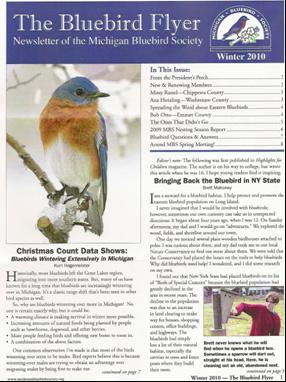Nest Box Basics
What You Need To Know About Bluebird Nest Boxes:
(Click on a title to go to that topic)
Why Do Bluebirds Nest in Nest Boxes?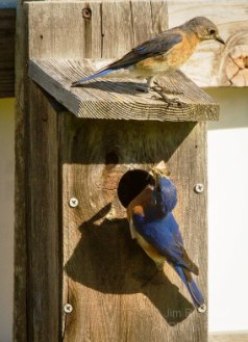
Where You Should Locate Nest Boxes
Different Bluebird Box Designs
Protecting Your Nest Box With Predator Guards
How To Maintain Your Nest Boxes
Setting Up A Bluebird Box Trail
Why Bluebirds Nest In Nest Boxes
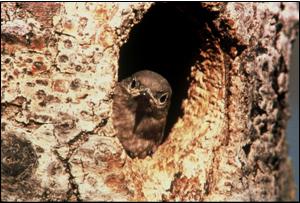 All bluebirds are classified as "cavity nesting birds". This means that their natural choice in nesting in the wild is some sort of hollowed out cavity in a tree. Before people put out nest boxes, natural cavities are what bluebirds nested in exclusively. Even now, some bluebirds will nest in these cavities, IF they can find them. And this is a big problem today, as available natural tree cavities are scarce. Why is this the case? There are several reasons:
All bluebirds are classified as "cavity nesting birds". This means that their natural choice in nesting in the wild is some sort of hollowed out cavity in a tree. Before people put out nest boxes, natural cavities are what bluebirds nested in exclusively. Even now, some bluebirds will nest in these cavities, IF they can find them. And this is a big problem today, as available natural tree cavities are scarce. Why is this the case? There are several reasons:
1. Extreme development has removed many trees which develop cavities.
2. Landscaping methods today tend to favor removal of dead or dying trees rather than leaving them as a home for wildlife. In nature, these types of trees are not removed, but left to gradually decay. And the process of this decay, taking place over years, provides food, shelter, and nesting sites for many animals including bluebirds.
3. Aggressive, competing species like house sparrows and starlings have taken over the few natural cavities that are available.
Bluebirds cannot create their own nesting cavities. They have to rely on either natural decay to create the space inside the tree or woodpeckers to excavate the cavity for them. Either way, the bluebird has to search extensively to find a suitable cavity in the right habitat.
All of this has created a shortage of bluebird nesting sites that has directly contributed to the decline of bluebirds for the the first 3/4 of the 1900's.
This is where bluebird nest boxes solve the problem. The nest box looks a lot like a natural nesting cavity to a bluebird. If it is designed to the proper dimensions and placed in a good location, bluebirds will respond readily. Please read below for more information.
Bluebird nest boxes are relatively easy and inexpensive to construct. You can make one for as little as $5 of material and some of your own time, or you can buy them pre-built for about $20 and up. If you have some recycled lumber that's in good shape, your cost will be a dollar or two for the material.
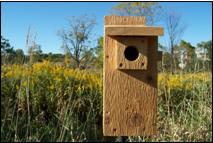 Dimensions - all Eastern bluebird boxes should have an entrance hole of 1 1/2" in diameter. This is large enough to let in eastern bluebirds, but too small to let in larger birds like starlings. However, there is some research that shows 1 9/16" is preferred by both Eastern and Western bluebirds. There are no exact dimensions for a bluebird box, but as a guideline, you want the floor to be about 4" by 4", up to 5" by 5", the distance from the bottom of the entrance hole to the floor to be around 5-6", and the distance from the top of the hole to the underside of the roof to be about 1 1/2". The roof should overlap the walls of the box to provide shelter from the rain. Usually, the roof should be at least 10" long and wider than the box (around 8 to 9 inches). There are some good design diagrams for download on our Nesting Box Plans page.
Dimensions - all Eastern bluebird boxes should have an entrance hole of 1 1/2" in diameter. This is large enough to let in eastern bluebirds, but too small to let in larger birds like starlings. However, there is some research that shows 1 9/16" is preferred by both Eastern and Western bluebirds. There are no exact dimensions for a bluebird box, but as a guideline, you want the floor to be about 4" by 4", up to 5" by 5", the distance from the bottom of the entrance hole to the floor to be around 5-6", and the distance from the top of the hole to the underside of the roof to be about 1 1/2". The roof should overlap the walls of the box to provide shelter from the rain. Usually, the roof should be at least 10" long and wider than the box (around 8 to 9 inches). There are some good design diagrams for download on our Nesting Box Plans page.
Materials - Most bluebird boxes are made of wood. The best types of wood to use are insect and rot-resistant species like red cedar, white cedar, and cypress. You can also use white pine, but it does not typically last as long as the first three. Another excellent material is recycled plastic, since it is rot-proof and impervious to damage from the sun. But, it is hard to find in regular home centers and lumber yards. PVC large diameter pipe can be used too as a body for the box. Wood should be at least 3/4" thick. This helps reduce warping somewhat and gives the box better insulation qualities for cold spring nights.
You should use wood screws to assemble the box instead of nails. The reason is that the screws hold the wood together much tighter as the wood dries and warps over time. Also, all hardware should be made of bronze alloy, stainless steel, coated, or galvanized steel to eliminate rusting.
Drainage/Ventilation - Another important feature is leaving openings in the bottom of the box for water to drain out. 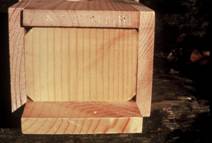 You can do this in several ways. One way is to simply drill 1/4" holes in the bottom of the box. Another way is to angle cut the four corners of the floor about 1/2" from the edge to allow water to drain via the corners. The final way is to leave a 1/4" to 3/8" gap between one wall and the floor.
You can do this in several ways. One way is to simply drill 1/4" holes in the bottom of the box. Another way is to angle cut the four corners of the floor about 1/2" from the edge to allow water to drain via the corners. The final way is to leave a 1/4" to 3/8" gap between one wall and the floor.
Ventilation is very important to help cool the box on hot spring or summer days. In addition to the entrance hole letting in air, you need to introduce some cross-ventilation by either leaving gaps between the roof and the tops of the two sides, or drilling 1 or 2 good-sized holes on each of the two sides about an inch or so from the roof.
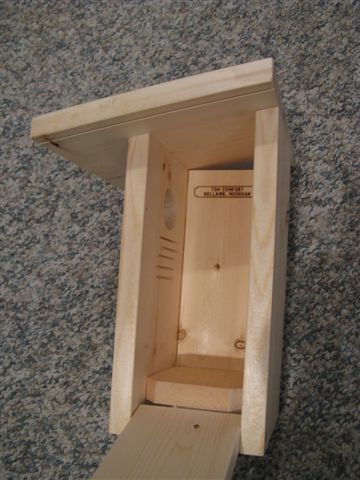
Opening For Cleaning - It's critically important when designing and building any bluebird box to include a way to open the box up to a) do regular nest checks, and b) to be able to clean out the nest box after the fledglings leave. Most designs have either a side panel, the box front, or the roof hinging up to get inside the box. You can a nail to hold the "door" shut most of the time.
No Perches - bluebird boxes do NOT need perches on the exterior of the box. Since bluebirds are cavity nesting birds, their feet are adapted to clinging to wood. Also, the presence of a perch may attract house sparrows which seem to prefer them.
Habitat is the single most important factor which will determine whether you attract bluebirds to nest in your box. You MUST locate the nest box in a location attractive to bluebirds. Good types of areas include golf courses, open subdivisions, farm fields, pastures, orchards, metroparks, open cemeteries, school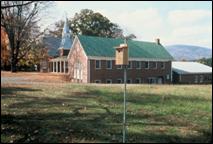 yards, and church yards.
yards, and church yards.
No one knows absolutely for sure why bluebirds choose one box over another. But, here are the location factors which statistically get the best results for "bluebird landlords":
1. Locate in an open, grassy field edge or lawn area away from trees.
2. Place the box about 5 feet off the ground on a wooden or metal pole.
3. Face the entrance hole AWAY from the west, north, or northwest, as this is the primary direction that spring/summer storms come from.
4. Place away from dense cover (shrubs, thickets) and woods.
5. Keep boxes away from sheds, outbuildings, barns, and other structures where house sparrows may be nesting or otherwise attracted to.
6. Perch areas near to the nest box are a big plus. These can be telephone poles, tomato stakes, small trees, etc.
7. Place the boxes away from bird feeders and your main house - at least 50 feet or more.
Spacing of Nest Boxes - if you have enough room for more than bluebird box, you need to put them about 250 to 300 feet apart. This is because bluebirds, like more nesting birds are territorial and will chase away other competing members of their own species. However, you CAN locate them closer together if the boxes are out of sight of each other. A good example is putting two boxes on opposite sides of the property with your house in between.
Also, bluebird pairs need a minimum of 1 1/2 to 2 acres of suitable habitat around their nest box in order to find sufficient food supplies. This doesn't mean that you have to have this much property in YOUR yard. It means that between your yard AND surrounding property there is the 1 1/2 to 2 acres of open land.
Good types of bluebird habitats include farmland, golf courses, orchards, metro parks and state parks, large office parks, suburban neighborhoods with large yards (1-3 acres), and ranches.
Different Designs Of Bluebird Boxes
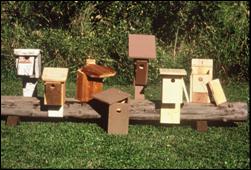 There is a large number of successful designs of bluebird boxes. Keep in mind there IS no one best box style. All of these designs have the basic dimensions that bluebirds need to raise a brood of 3 to 8 young. The most important attribute is the location of the box and surrounding habitat.
There is a large number of successful designs of bluebird boxes. Keep in mind there IS no one best box style. All of these designs have the basic dimensions that bluebirds need to raise a brood of 3 to 8 young. The most important attribute is the location of the box and surrounding habitat.
Peterson Box - this highly successful design was developed in Minnesota by Dick Peterson, and feat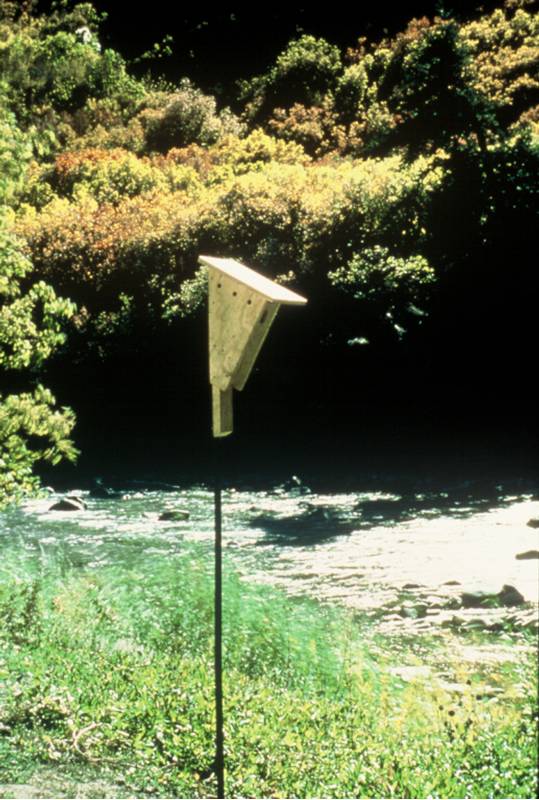 ures a large, angled roof, angled sides, a small sloping floor, and a vertical, oblong hole instead of the traditional round one. The advantages of this design are a) the slanted floor keeps the nest drier, b) the large, angled roof makes it harder for predators to reach the nest, c) ease of nest checks via the front panel which swings down. The disadvantages of this box are a) it's a complicated design to build requiring better than average tools and woodworking skills, b) the box is heavier than most other designs and trickier to mount, c) the box is NOT completely starling proof, as they are sometimes able to squeeze into the oval opening. But, starlings don't prefer it as a nesting site and will usually go elsewhere.
ures a large, angled roof, angled sides, a small sloping floor, and a vertical, oblong hole instead of the traditional round one. The advantages of this design are a) the slanted floor keeps the nest drier, b) the large, angled roof makes it harder for predators to reach the nest, c) ease of nest checks via the front panel which swings down. The disadvantages of this box are a) it's a complicated design to build requiring better than average tools and woodworking skills, b) the box is heavier than most other designs and trickier to mount, c) the box is NOT completely starling proof, as they are sometimes able to squeeze into the oval opening. But, starlings don't prefer it as a nesting site and will usually go elsewhere.
NABS-Style Box- This is a fairly, simple nest box design which can be made from a typical 1 by 6" board of lumber. It has a slightly angled roof and opens from the side via the panel which hinges up. You can find the plans for a NABS type of box on our Nest Box Plans page.
Gilbertson Nest Box - This unusual design is made from a 4-inch diameter PVC pipe. The box is only 4 1/2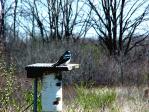 inches deep from the hole to the floor. It uses a cedar floor, and a cedar roof which the box body fits into. This box is one of the most sparrow resistant designs on the market. The shallow depth is not liked by many house sparrows. Also, the PVC body is somewhat harder for them to grasp. Although the box has proven to be at the top of this sparrow-resistant list, field experience in recent years has shown that sparrows may still use the box. So, it is not foolproof.
inches deep from the hole to the floor. It uses a cedar floor, and a cedar roof which the box body fits into. This box is one of the most sparrow resistant designs on the market. The shallow depth is not liked by many house sparrows. Also, the PVC body is somewhat harder for them to grasp. Although the box has proven to be at the top of this sparrow-resistant list, field experience in recent years has shown that sparrows may still use the box. So, it is not foolproof.
Gilwood Nest Box - This nest box is another design of Steve Gilbertson, 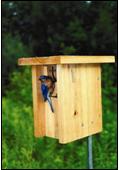 and incorporates an unusual entrance hole design that has been found to be not liked by sparrows. It is another of the "less is more" type of nest boxes in that the relatively small inner nesting space is being found to be more successful than larger cavities. It's not as easy of a design to make for woodworkers of average or beginning skills. But, it can be built for a modest cost. The box has gotten good reviews by people who have used it. There is a plan for a modified version of the Gilwood box on our Nest Box Plans page.
and incorporates an unusual entrance hole design that has been found to be not liked by sparrows. It is another of the "less is more" type of nest boxes in that the relatively small inner nesting space is being found to be more successful than larger cavities. It's not as easy of a design to make for woodworkers of average or beginning skills. But, it can be built for a modest cost. The box has gotten good reviews by people who have used it. There is a plan for a modified version of the Gilwood box on our Nest Box Plans page.
Kentucky Bluebird Box - Also called a "Slot box" design, this box uses an entrance slot the width of 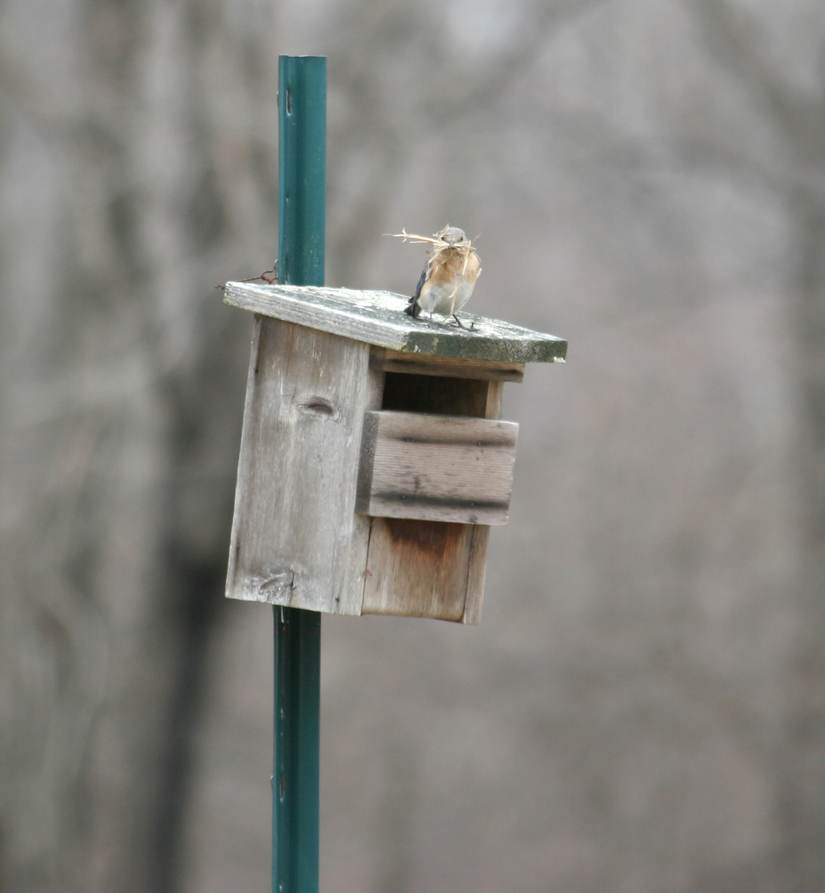 the box instead of a round or oval hole. So, the box is easier to enter by bluebirds and other birds. The box usually has a flat or slightly sloped roof. The Kentucky box is shallower than other bluebird boxes. The distance from the slot to the floor is around 4-5 inches. Because sparrows don't like shallow nest boxes, using this box can help discourage them. But, again, field experience has shown that they just adapt to it sometimes. An advantage though, is that the slot design makes it much easier for bluebirds to escape from the box in case a house sparrow enters the box to attack the bluebird. (This can happen with other designs, usually resulting in the demise of the bluebird).
the box instead of a round or oval hole. So, the box is easier to enter by bluebirds and other birds. The box usually has a flat or slightly sloped roof. The Kentucky box is shallower than other bluebird boxes. The distance from the slot to the floor is around 4-5 inches. Because sparrows don't like shallow nest boxes, using this box can help discourage them. But, again, field experience has shown that they just adapt to it sometimes. An advantage though, is that the slot design makes it much easier for bluebirds to escape from the box in case a house sparrow enters the box to attack the bluebird. (This can happen with other designs, usually resulting in the demise of the bluebird).
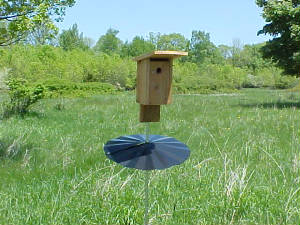 It is really CRITICAL that when you put up bluebird boxes in your yard, that you protect the boxes from climbing predators (how to mount bluebird boxes will be discussed in the next section). Bluebirds are often the target of predators such as raccoons, squirrels, cats, snakes, and hawks. These animals are most often after the bluebird eggs and young. Raccoons are probably the biggest concern for most bluebird landlords, although cats and squirrels can be a concern in some cases. Snakes are not usually a problem in this part of the country. But, a good predator guard can solve the problem of snakes climbing the pole. Hawk attacks can not be prevented.
It is really CRITICAL that when you put up bluebird boxes in your yard, that you protect the boxes from climbing predators (how to mount bluebird boxes will be discussed in the next section). Bluebirds are often the target of predators such as raccoons, squirrels, cats, snakes, and hawks. These animals are most often after the bluebird eggs and young. Raccoons are probably the biggest concern for most bluebird landlords, although cats and squirrels can be a concern in some cases. Snakes are not usually a problem in this part of the country. But, a good predator guard can solve the problem of snakes climbing the pole. Hawk attacks can not be prevented.
The easiest and best type of predator guard to put on your pole is a cylindrical metal stove-pipe-shaped baffle with a metal top. The top has a hole in the middle which the bluebird pole goes through. The metal baffle will then rest on a collar or other form of "rest" which is clamped onto the pole. The baffle should be made out of galvanized steel or heavy duty aluminum. This will prevent squirrels or raccoons from chewing it and making it easier to climb. The cylinder should be 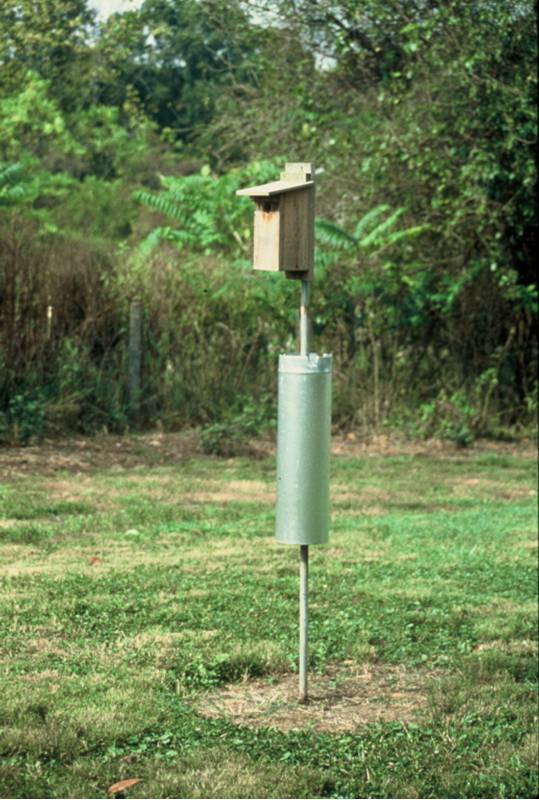 between 6 and 8 inches in diameter for maximum effectiveness. The top of the baffle needs to be solid with minimal gaps between the baffle and pole. This is to prevent chipmunks or snakes from squeezing through the gap.
between 6 and 8 inches in diameter for maximum effectiveness. The top of the baffle needs to be solid with minimal gaps between the baffle and pole. This is to prevent chipmunks or snakes from squeezing through the gap.
The baffle should be located high enough off the ground to prevent animals from jumping over the top of it. The top of the baffle should be between 4 and 4 1/2 feet off the ground. This will prevent squirrels from leaping over it. Raccoons can't jump, so height is not as much of a concern.
Deterring cats is often harder to do, because cats' preferred way of getting at bluebirds is to try and leap at the adult birds as they are leaving and entering the box. Cats can leap over 5 feet high, so this is a problem. They will often lurk on the ground near the nest box. This is one reason why it is important to mow the grass and weeds in a radius of at least 6 to 8 feet around the bluebird box pole. A solution to this problem is to build a cone shaped baffle of at least a 30" diameter to put on top of the cylinder baffle. This will prevent the cat from leaping straight up near the box.
There are some types of predator guards which attach to the front of the bluebird box to make it harder for predators to reach into the nest box. Many of these are either not very effective or are not liked by bluebirds much. Basically, they take the form of PVC tunnels, or wire-cloth boxes which lengthen the distance from the inside of the box where the nest is, to where the predator is trying to reach from. But, unless the guard is very firmly secured to the front of the box, raccoons can often rip them off the box. Also, bluebirds will sometimes abandon the nest unless they have already laid eggs. The best design seems to be a 4-inch diameter PVC pipe section, 6 inches long that is capped on one end. The capped end will have a 1 1/2" hole drilled through it for the bluebirds to enter, and the other end will be secured to the box front.
Greasing or waxing the pole can be an option, but is normally more of a short term solution. Unless the lubricants are re-applied often, predators may climb the pole.
Also, do not hang bluebird boxes from trees. It is virtually impossible to keep predators from climbing the tree and reaching the bluebird box. Mounting the nestboxes to fences is also not a good plan, unless the box is isolated from most arboreal predators.
Sometimes, using 1/2 inch electrical conduit will not require the use of a predator guard IF the pole is waxed or some sort of oil applied to make it slippery.
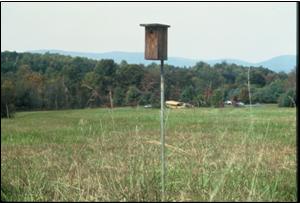 Bluebird boxes should be mounted on a free standing pole if at all possible. This is because it is far easier to protect the nest from climbing predators when a pole is used in conjunction with a predator guard (see previous section). Also, when using a pole, you are not limited in where to locate the box. Round metal poles are probably easiest to work with, but metal fence posts and wooden poles can work well also. The pole should be 5 feet high AFTER installing it in the ground. Usually, you will need 12" to 18" of the pole buried in the ground for optimum stability. Even then, depending on the soil type, you will probably need to straighten the pole from time to time. This is because the combination of wind and the soil getting wet will cause the pole to lean.
Bluebird boxes should be mounted on a free standing pole if at all possible. This is because it is far easier to protect the nest from climbing predators when a pole is used in conjunction with a predator guard (see previous section). Also, when using a pole, you are not limited in where to locate the box. Round metal poles are probably easiest to work with, but metal fence posts and wooden poles can work well also. The pole should be 5 feet high AFTER installing it in the ground. Usually, you will need 12" to 18" of the pole buried in the ground for optimum stability. Even then, depending on the soil type, you will probably need to straighten the pole from time to time. This is because the combination of wind and the soil getting wet will cause the pole to lean.
You SHOULD NOT mount bluebird boxes on the sides of trees, fences, or buildings. These are very difficult if not impossible to protect from climbing predators. Also, do NOT hang bluebird boxes. They seem to prefer fixed boxes that are not swinging randomly in the wind.
Usually, when mounting the bluebird box to the pole, you will need some way of attaching the box. Pipe clamps can be often be used, which clamps the pole to the back of the box. Pipe flanges are sometimes used too. Usually, the box will be attached to the top of the pole in this case vs. the side of the pole with the pipe clamp option. Also, some bird feeding supply stores sell poles specially made for bluebird boxes, which are easy to put in the ground. They also sometimes sell separate flanges to mount the box to the pole.
Another system developed by Steve Gilbertson, that has been found to work well is 1/2" electrical conduit and reinforcing bar, or re-bar.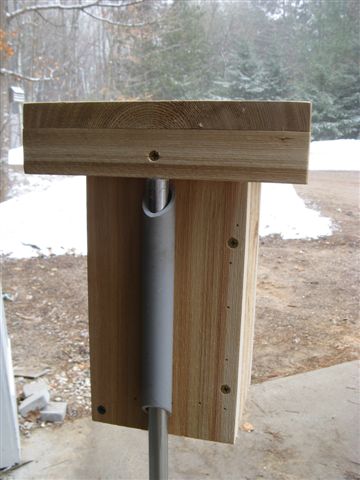 You would need a 5 foot tall section of conduit and 4 or 5 foot high length of rebar. Also, you will need a block of wood on the back of the box into which you can drill a 3/4" hole, about 1 1/2" deep to receive the conduit. Drive the rebar into the ground about 15 to 18 inches, making sure it is straight. Then slide the conduit pipe over the rebar and just embed it in the ground. Then mount the nest box on top of the conduit. An extra 1/2" pipe clamp or piece of PVC pipe can then be used to secure the box to the pole so that it doesn't twist easily. You're now set to go!
You would need a 5 foot tall section of conduit and 4 or 5 foot high length of rebar. Also, you will need a block of wood on the back of the box into which you can drill a 3/4" hole, about 1 1/2" deep to receive the conduit. Drive the rebar into the ground about 15 to 18 inches, making sure it is straight. Then slide the conduit pipe over the rebar and just embed it in the ground. Then mount the nest box on top of the conduit. An extra 1/2" pipe clamp or piece of PVC pipe can then be used to secure the box to the pole so that it doesn't twist easily. You're now set to go!
You can download this diagram showing how the 1/2" electrical conduit mounting system works. (NOTE: you must have the Adobe Acrobat Reader software installed on your computer to open this PDF file.) Nest Box Monitoring
It is very, very important to monitor the progress of each of your bluebird nest boxes. Why is this 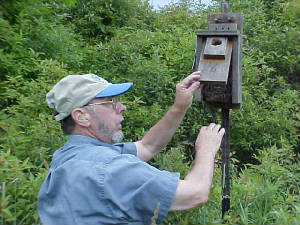 important?
important?
1. You need to know what kind of bird may be nesting or trying to nest in your box. Is it a bluebird? A tree Swallow? A House Sparrow? By looking at the nest type, you can tell the type of bird that is using the box. If it is a house sparrow nest, you need to take action to remove them from the box. For strategies for controlling house sparrows, see the Problem Solving page.
2. If there are problems with the bluebird box, you need to know what they are so you can solve them. For instance, you can check for blowfly or ant infestations. Also, you can tell if sparrows have attacked the nest. The only way to know these things is by checking your nest box regularly.
3. Recording data for nest boxes is very useful and can be helpful to bluebird conservation efforts if reported to the Michigan Bluebird Society and/or the North American Bluebird Society. It also helps you in learning about bluebird life cycles and understanding how to improve your nesting success rates.
Nest box monitoring should be done from the first time you see bluebirds building a nest in your box through the date the young fledge. This can be done with a simple data form. We have a bluebird nest box monitoring form you can download from this site.
As discussed in our section on nest box construction, it is critical to have a box that can be opened easily for nest checks and for cleaning the box out. Nest box checks should be done in the morning so that your scent has dissipated sufficiently by the evening hours when raccoons are foraging the most. Walk up near the box, make several sounds so the bluebirds hear you coming, and then tap gently on the side of the box. Usually, the female will fly out. But, sometimes, she will remain on the nest when you open the box!
When she leaves the nest, you can check to see if there is any activity, what is the progress of the nest, how large the young are, etc. Write down anything significant on your data form. Close the box up, and quickly walk away. Nest checks can be done a minute or less usually. As your experience grows, you can take more detailed data and even pick up the young. (Don't worry about handling the young as long as you are gentle. The parents will NOT abandon the young just because you have looked at their nest or handled the babies).
Nest checks can be done up until about the time they are 12 days old. After that, there's a risk that the birds will prematurely fledge from the box if you open it up. At this point, the birds are not able to fly and will most likely perish if they leave the nest box. So, at this point, just keep monitoring the box from a distance. Notice whether the parents are still coming in and out of the box. Eventually, you will see the young around the entrance hole and sometimes protruding their heads outside the box. This means that fledging day is imminent. It is a rare treat to be on hand when the young birds leave the nest for the first time.
For a complete list of problems which can occur and how to deal with them, go to our Problem Solving Page.
At the end of the nesting season, it is a very good idea to compile the results of all your nesting boxes in a summary report and submit it to the Michigan Bluebird Society. You can download a data form to submit your results on here.
There's little that you need to do to maintain you nesting box. If the box is made of cedar or cypress, you don't really need to paint it or stain it. The wood will naturally weather to a pleasant grey color. However, if you do decide to preserve the wood, use only non-toxic stains and paints on the OUTSIDE of the box only. Some people have used linseed oil on wooden boxes to preserve them as well.
Nest boxes should be cleaned out after each brood of young leave the nest. It is also a good idea to wash out the inside of the box with a 10% bleach/water solution. This is because the inside of the box will usually have a lot of droppings and feather mites in it. Rinse the box out thoroughly and let it completely dry before re-mounting it. If you would like the nest box to last longer, you can put it in the garage in the late summer (September) after the birds are done using it.
Bluebird nest boxes can be left out in the fall and winter for over-wintering bluebirds to use for shelter also. You can often tell if bluebirds are using these boxes by the berry droppings left inside.
Each spring, inspect each bluebird box for any necessary maintenance. Screws sometimes need to be tightened. Replace any wood sections that have been severely damaged. Usually the roof receives the most weathering and will often warp and crack the soonest of any of the other parts of the box. This is also a good time to straighten mounting poles and check baffles for damage.
Damage from birds and squirrels - It's not uncommon for woodpeckers and squirrels to damage bluebird boxes. Downy woodpeckers can actually enter the box, but will sometimes drill holes on the side or back of the box. Also, they may try to enlarge the entrance holes. Similarly, squirrels will sometimes attempt to chew around the hole to make it bigger for them to enter. It's hard to prevent this type of damage completely. But, there are metal or ceramic rings you can buy which attach to the box around the entrance hole to prevent the enlarging. Also, some companies make a chemical spray which you can spot treat the box with, which has a bitter taste to mammals. It doesn't hurt them, but will stop them permanently from chewing once they get it in their mouth.
How To Set Up A Bluebird Trail
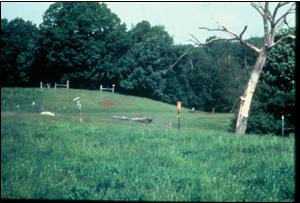 A bluebird trail is basically a linear group of bluebird boxes along an easily traversed path that can be monitored as a group. Bluebird trails can be as few as 4 or 5 boxes or as many as several thousand. They are usually set up along easily traveled paths such as roads, dirt trails, fence lines, etc. and can be set up almost anywhere. Golf courses, business parks, farm areas, metroparks, and rural roads are just a few of the places where bluebird trails can be set up successfully.
A bluebird trail is basically a linear group of bluebird boxes along an easily traversed path that can be monitored as a group. Bluebird trails can be as few as 4 or 5 boxes or as many as several thousand. They are usually set up along easily traveled paths such as roads, dirt trails, fence lines, etc. and can be set up almost anywhere. Golf courses, business parks, farm areas, metroparks, and rural roads are just a few of the places where bluebird trails can be set up successfully.
Usually a bluebird trail is set up by an individual or group who will also monitor the boxes and record nesting data. The nest boxes are much easier to monitor since they are set up in a linear path which can easily be checked by one or more people. In this case, each box is numbered so that nest box data results can be tracked for it from year to year.
Once an area has been identified as a good place for a bluebird trail, the organizer needs to receive permission from the land owner(s) involved to put up the nest boxes. This may involve a little education about what will need to be done on a regular basis - that is, monitoring and maintenance. This is not a "set it and forget it" type of project. Monitors will need access to the boxes once or twice a week during the nesting season and several other times for necessary maintenance. Then, there needs to be agreement on where the nest boxes will be placed and how. Golf courses, for instance, will be sensitive to this. Many of them will insist on boxes being put on trees since they don't want a bunch of poles which can be hit by lawn mowers.
Setting up a large bluebird trail can be expensive unless boxes, predator baffles, and poles are donated. Depending on the habitat, sometimes you can cut corners on things like predator guards, if it's pretty remote land with few raccoons. Sometimes, guards which attach to the box can be used to save money. Poles and wood can be recycled to save more money. Finally, the trail can be grown over time so that the costs of the new housing can be spread out gradually. Then, volunteers and schedules need to be set up so that all nest boxes are monitored on a regular basis.
Bluebirds will sometimes winter over in Michigan. In this case, they will sometimes use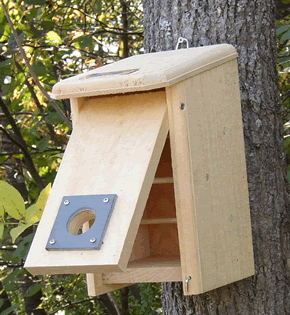 bluebird nesting boxes that are left out as a place to get shelter on cold winter nights. When doing this, they will often roost in groups of as few as several birds to several dozen. You can temporarily "winterize" your nesting box by plugging up the ventilation openings with weather stripping. This helps keep the box warmer in the winter.
bluebird nesting boxes that are left out as a place to get shelter on cold winter nights. When doing this, they will often roost in groups of as few as several birds to several dozen. You can temporarily "winterize" your nesting box by plugging up the ventilation openings with weather stripping. This helps keep the box warmer in the winter.
You can also build or buy a nest box made for winter roosting. Typically, this box is larger with an opening near the bottom, rather than the top of the box. Then, inside the box, there are staggered perches where birds can sit on all night. The top of the box has no ventilation openings, so it will stay much warmer inside. Because warm air rises, the box will stay warm even longer.
